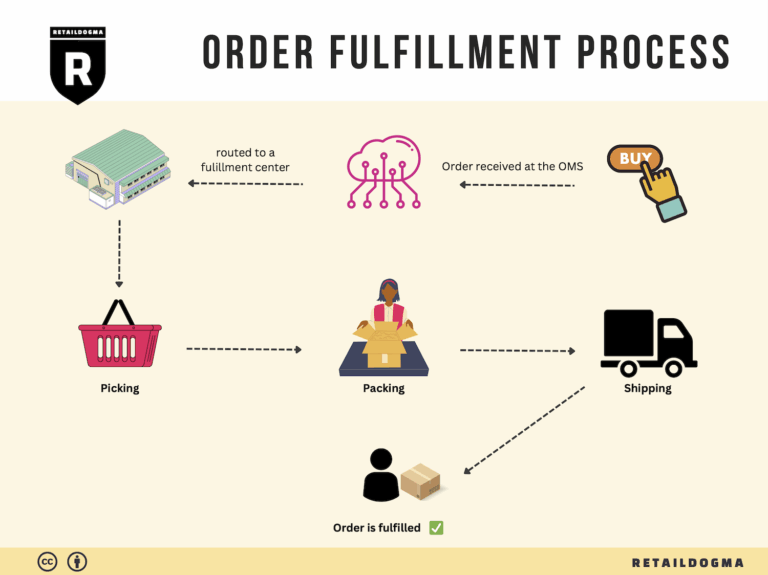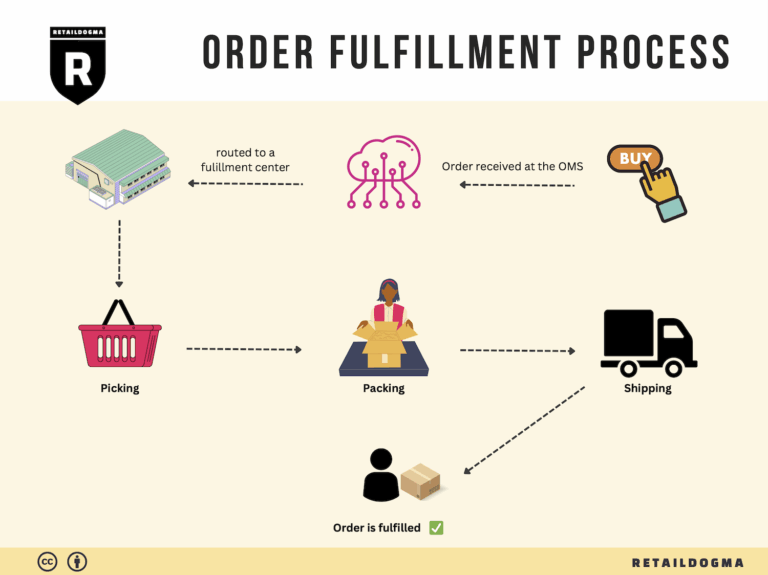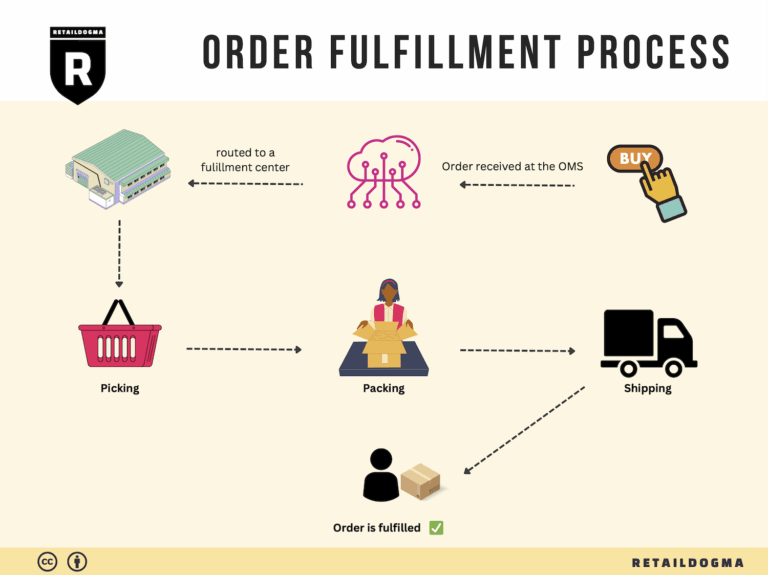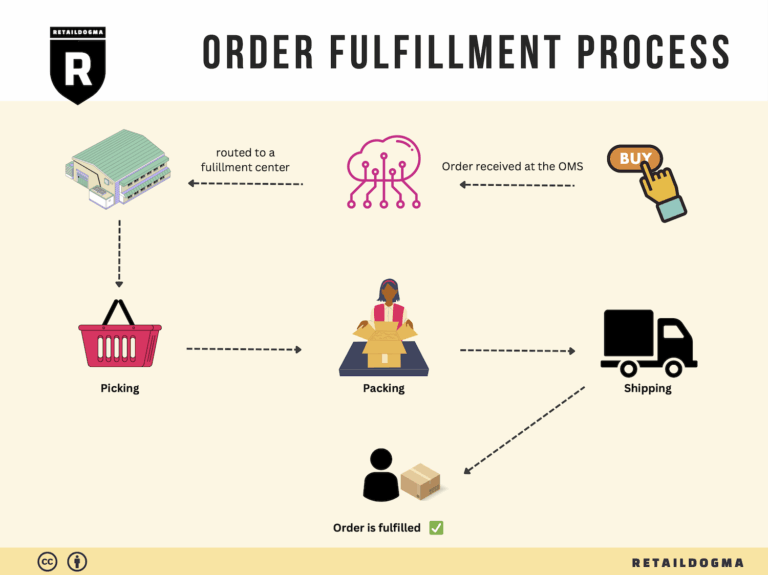What Is A Fulfillment Center? A Complete Guide (2025)
What is E-commerce Fulfillment? An Introduction for Growing Businesses
The Challenge of Order Fulfillment in E-commerce
As your online business begins to grow, the excitement of increased sales can quickly turn into a daunting challenge: managing the packing and shipping of orders. Many e-commerce entrepreneurs find themselves overwhelmed by the logistics of fulfillment, struggling to keep pace with customer expectations for fast, accurate delivery. This is where understanding e-commerce fulfillment becomes crucial.
Fulfillment is simply the process of getting a product from your inventory to your customer’s doorstep. It encompasses a series of steps, from receiving and storing inventory to picking, packing, and shipping orders. For growing businesses, effectively managing these steps is vital to maintaining customer satisfaction and sustaining growth.
What This Guide Covers
In this guide, we will explore the various models of fulfillment, including Fulfillment by Amazon (FBA) and third-party logistics (3PL). Each model has distinct advantages and challenges, and understanding these can help you make informed decisions tailored to your business needs.
We will also delve into core fulfillment services that play a critical role in the logistics process. These include inventory management, order processing, shipping, and returns management. By grasping the key components of these services, you can streamline your operations and enhance your customer experience.
Another essential aspect we will cover is how to choose the right fulfillment partner. The right partner can significantly impact your operational efficiency and customer satisfaction. We will discuss the criteria you should consider when evaluating potential partners, including their technology capabilities, service offerings, and scalability.
Finally, we will look at pricing models associated with different fulfillment options. Understanding the cost implications of each model will empower you to select a solution that aligns with your budget while meeting customer demands.
Empowering Your Business Decisions
The goal of this guide is to empower you to make smart, strategic decisions about your logistics. By equipping yourself with knowledge about e-commerce fulfillment, you can alleviate the stress of order management, improve efficiency, and ultimately enhance your customers’ shopping experience. Let’s dive in and explore how you can optimize your fulfillment strategy for sustained growth in your e-commerce business.
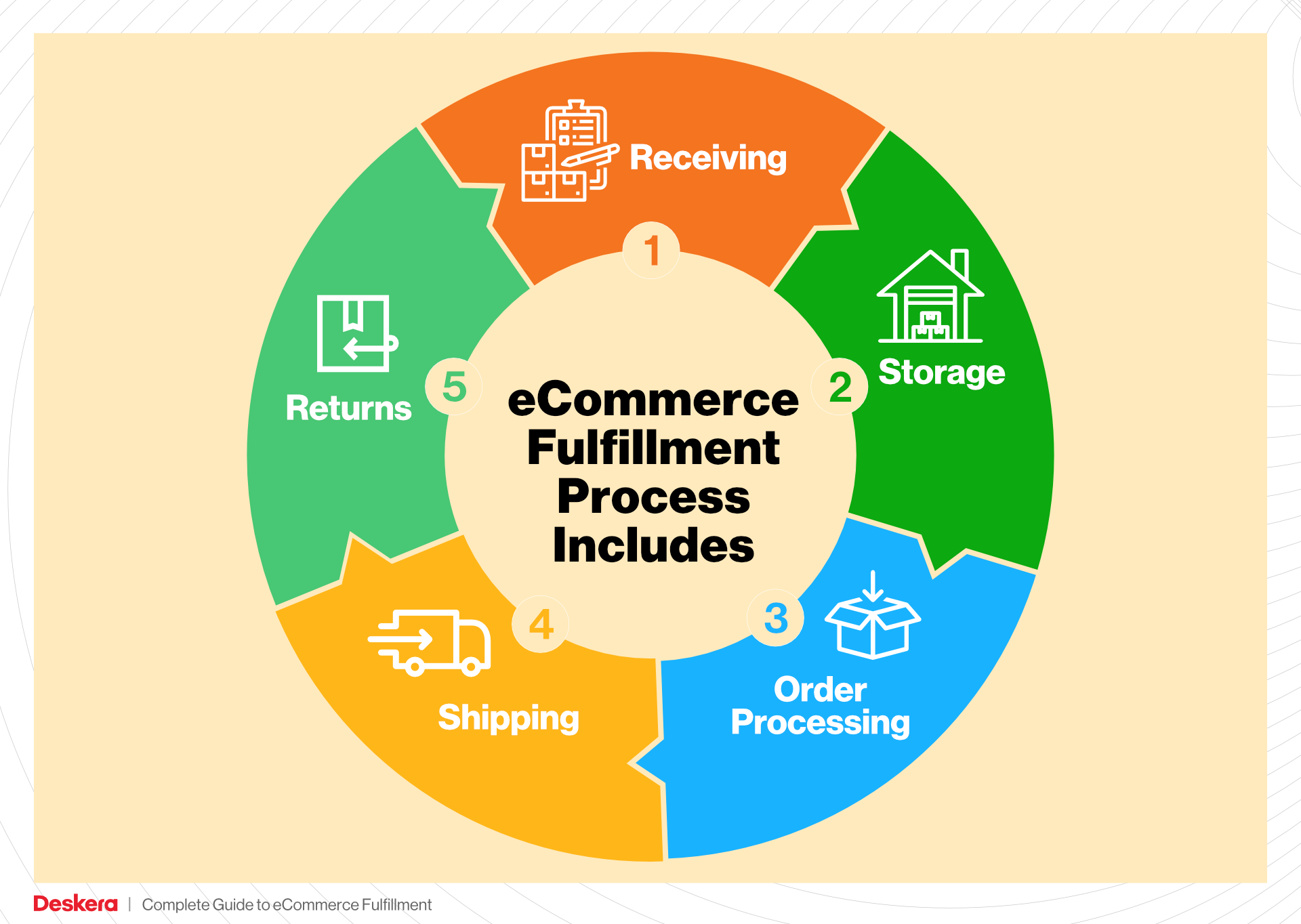
What You’ll Learn In This Guide
- What is E-commerce Fulfillment? An Introduction for Growing Businesses
- The Order Fulfillment Process: From ‘Buy’ Button to Customer’s Door
- Comparing Fulfillment Models: In-House vs. 3PL vs. Dropshipping
- A Deep Dive into Amazon FBA: Pros, Cons, and Who It’s For
- Core Services Offered by Fulfillment Centers
- How to Choose a Fulfillment Partner: A 6-Point Checklist
- Understanding Fulfillment Pricing: A Breakdown of Common Fees
- Frequently Asked Questions (FAQs) about Fulfillment
- Conclusion: Is Outsourcing Fulfillment the Right Move for Your Business?
- Important Disclaimer
The Order Fulfillment Process: From ‘Buy’ Button to Customer’s Door
1. Receiving Inventory
The order fulfillment process begins with receiving inventory at the warehouse. When products are shipped from suppliers or manufacturers, they arrive at the fulfillment center where warehouse associates check the incoming shipments against purchase orders. This step is critical as it ensures that the correct quantities and items have been delivered.
During this phase, items are often identified using Stock Keeping Units (SKUs), which are unique identifiers that help in tracking inventory throughout the supply chain. The receiving team inspects the goods for damage and verifies that the items match the order specifications. Proper receiving practices minimize discrepancies and ensure that the inventory is accurate from the outset, setting the stage for efficient order processing later on.
2. Warehouse Storage
Once the inventory is received and verified, the next step is warehouse storage. Products are organized and shelved in designated areas of the fulfillment center. Effective storage is vital for maximizing space and ensuring that items can be easily accessed when needed.
Warehouse management systems (WMS) play a pivotal role in this phase by tracking the location of every item stored. The use of a systematic storage method, such as FIFO (First In, First Out) or LIFO (Last In, First Out), can help in managing inventory more effectively. Proper organization not only aids in quick retrieval but also helps in maintaining stock levels, reducing the chances of overstocking or stockouts.
3. Order Picking
When a customer places an order, the order fulfillment process transitions to order picking. This is where warehouse associates gather the items listed on the order, often using pick lists that detail the specific products and quantities required.
Order picking is a crucial step, as it directly impacts the accuracy and speed of fulfilling customer orders. There are various picking methods, including single order picking, batch picking, and zone picking, each suited to different types of operations. Efficient picking strategies can significantly enhance productivity and reduce the time taken to fulfill orders, ultimately improving customer satisfaction.
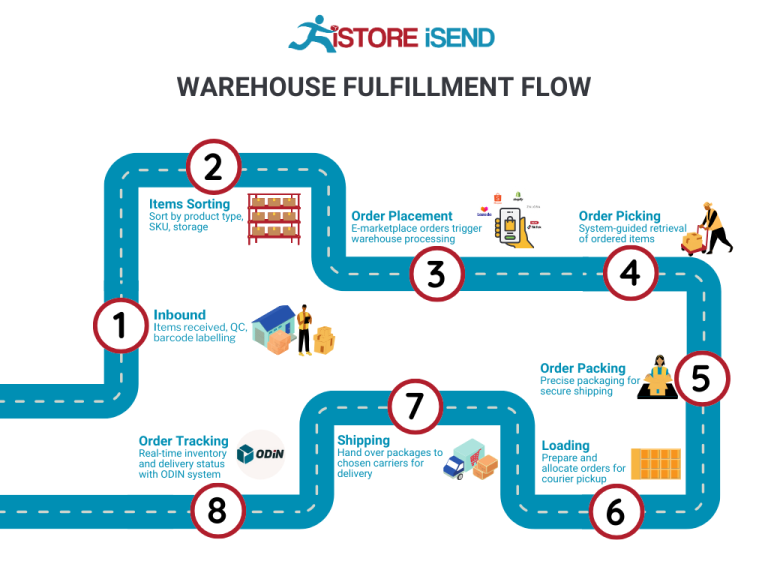
4. Order Packing
After items have been picked, they move to the order packing stage. This step involves carefully packaging the products to ensure they arrive at the customer’s door in pristine condition. Associates select appropriate packaging materials, such as boxes, bubble wrap, or packing peanuts, depending on the nature of the items being shipped.
Packing is essential not only for protecting the products during transit but also for optimizing shipping costs. Properly packed orders can maximize space in shipping containers and reduce the risk of damage, which can lead to costly returns and customer dissatisfaction. Additionally, packing slips that include essential information about the order, such as item descriptions and return instructions, are often included to enhance the customer experience.
5. Shipping & Delivery
The final step in the order fulfillment process is shipping and delivery. Once orders are packed, they are labeled and prepared for dispatch. This involves selecting the most efficient shipping method based on factors like delivery speed, cost, and destination.
Shipping logistics can be complex, requiring coordination with various carriers and understanding their specific requirements. Key performance indicators (KPIs), such as delivery time and shipping accuracy, are monitored to assess the efficiency of the shipping process. Effective shipping strategies not only ensure that customers receive their orders on time but also contribute to overall operational efficiency and cost management.
In conclusion, the order fulfillment process is a multi-step operation that requires careful planning and execution. Each phase, from receiving inventory to shipping and delivery, plays a crucial role in ensuring customer satisfaction and operational efficiency. By understanding and optimizing these steps, e-commerce businesses can enhance their logistics capabilities and scale effectively.
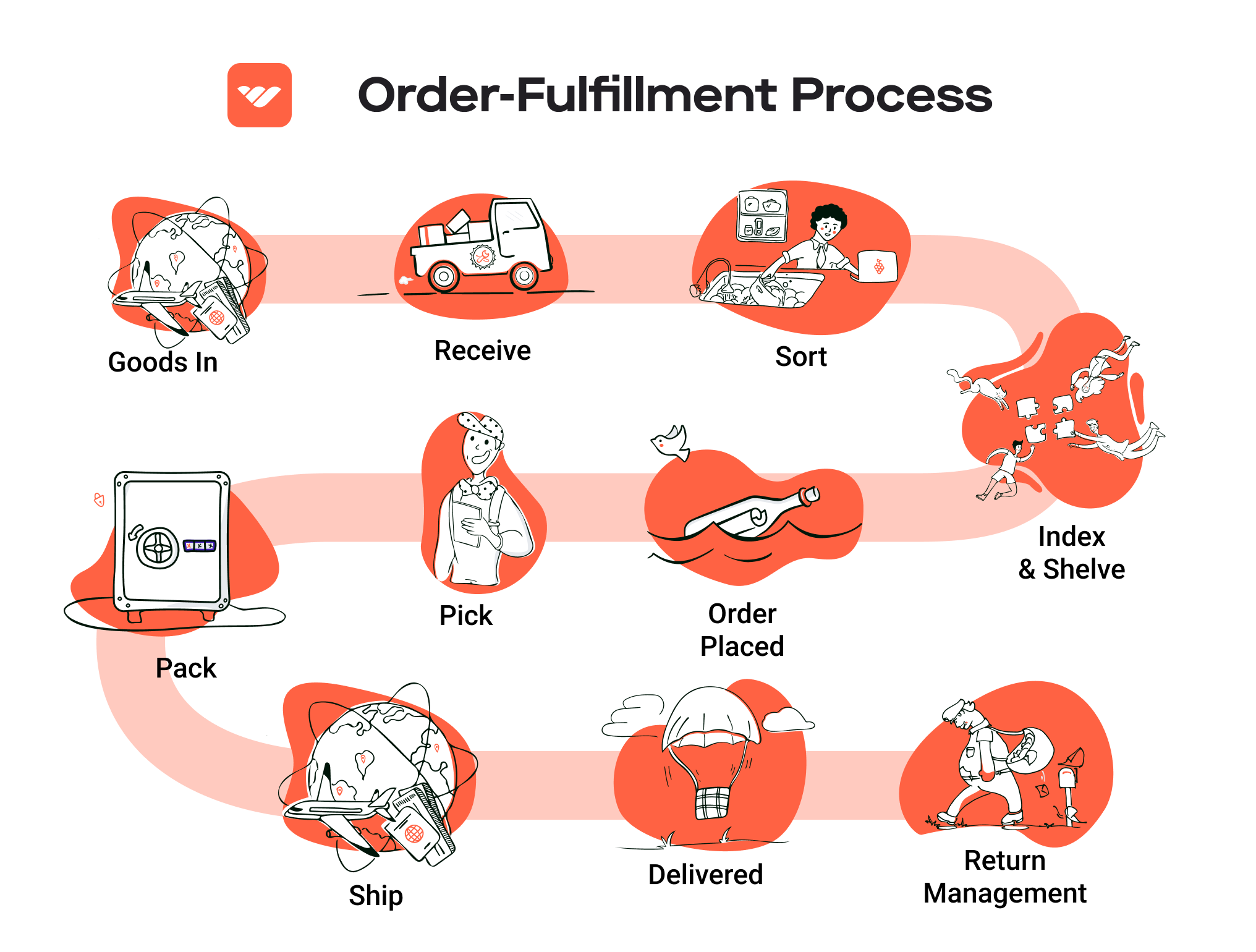
Comparing Fulfillment Models: In-House vs. 3PL vs. Dropshipping
Fulfillment Model Comparison
| Model | Who Handles Inventory | Best For (Business Stage) | Key Advantage | Key Disadvantage |
|---|---|---|---|---|
| In-House Fulfillment | Business (Own Staff) | Startups to Established | Full control over inventory and processes | High overhead costs and resource demand |
| Third-Party Logistics (3PL) | Third-Party Provider | Growing to Established Businesses | Scalable and flexible operations | Less control over fulfillment quality |
| Dropshipping | Supplier | Startups to Small Businesses | Low startup costs and no inventory risk | Lower profit margins and longer shipping times |
In-House Fulfillment
In-house fulfillment involves managing the entire logistics process within your own facilities. This means your business is responsible for storing, picking, packing, and shipping products directly to customers. This model is often preferred by startups and established businesses that want complete control over their inventory and fulfillment processes. The key advantage of in-house fulfillment is that it allows for tailored customer experiences and quality control, ensuring that products are handled according to your standards. However, this model comes with significant overhead costs, including staffing, warehousing, and technology investments. Additionally, managing logistics can be resource-intensive, requiring a dedicated team and ongoing operational adjustments, particularly during peak seasons. For businesses aiming for rapid growth, the scalability of in-house fulfillment can be a challenge, as increased order volume may necessitate further investment in infrastructure.
Third-Party Logistics (3PL)
Third-party logistics (3PL) providers take on the responsibility of managing logistics for businesses. This model is ideal for growing companies that want to focus on their core competencies without getting bogged down by the complexities of warehousing and shipping. 3PLs handle everything from inventory management to order fulfillment, allowing businesses to scale operations quickly without significant upfront investments in infrastructure. The key advantage of using a 3PL is the flexibility it offers; businesses can adjust their logistics needs according to changing market demands without the burden of maintaining their own facilities. However, a significant downside is the reduced control over the fulfillment process. Relying on a third party can lead to inconsistencies in service quality and customer experience, which may affect brand reputation. Additionally, businesses must carefully choose their 3PL partners, as not all providers offer the same level of service or technology integration.
Dropshipping
Dropshipping is a fulfillment model where businesses sell products without holding any inventory. Instead, when a customer places an order, the business purchases the item from a third-party supplier, who then ships it directly to the customer. This model is particularly advantageous for startups and small businesses looking to minimize startup costs and financial risk, as there is no need to invest in inventory upfront. The lack of inventory management allows entrepreneurs to focus on marketing and customer acquisition rather than logistics. However, dropshipping comes with its own challenges. Profit margins can be significantly lower than other fulfillment methods, as suppliers often charge higher prices for the convenience of dropshipping. Additionally, businesses have little control over shipping times and product quality, which can lead to customer dissatisfaction if issues arise. Furthermore, reliance on suppliers can create vulnerabilities in the supply chain, particularly if a supplier runs out of stock or fails to deliver on time.
In summary, choosing the right fulfillment model is critical for scaling an e-commerce business. Each model has its unique advantages and disadvantages, and the best choice will depend on your business stage, operational capabilities, and growth objectives. Understanding these differences will empower business owners to make informed decisions that align with their strategic goals.
A Deep Dive into Amazon FBA: Pros, Cons, and Who It’s For
Understanding Fulfillment by Amazon (FBA)
Fulfillment by Amazon (FBA) is a service that allows e-commerce sellers to leverage Amazon’s vast logistics network to store, pack, and ship their products. By using FBA, sellers can focus on their core business activities—like sourcing and marketing—while Amazon handles the complexities of order fulfillment. This service is particularly appealing to small to medium-sized businesses looking to scale without investing heavily in their own warehousing and shipping infrastructure.
When a seller enrolls in FBA, they send their inventory to Amazon’s fulfillment centers. Once the products are in Amazon’s warehouses, the seller’s listings become eligible for Amazon Prime and other Amazon services. When a customer places an order, Amazon takes care of storage, packing, and shipping, as well as customer service and returns. This not only streamlines the sales process but also enhances the shopping experience for customers, who benefit from fast shipping and reliable service.
How FBA Works
-
Inventory Management: Sellers create an Amazon seller account and set up their FBA preferences. They then ship their products to Amazon’s fulfillment centers. Amazon provides guidelines on how to label and package items for shipment.
-
Storage: Once received, products are stored in Amazon’s warehouses. Sellers are charged storage fees based on the volume of inventory stored.
-
Order Processing: When a customer places an order, Amazon picks the item from its inventory, packs it, and ships it directly to the customer. This process is designed to be efficient and typically results in fast delivery times.
-
Customer Service: Amazon also handles customer service inquiries and returns for FBA orders, which reduces the operational burden on sellers.
-
Payments: After the order is fulfilled, the seller receives payments, minus Amazon’s fees for the FBA service.
Pros of FBA
1. Prime Eligibility
One of the standout benefits of FBA is that it makes products eligible for Amazon Prime. With millions of Prime members seeking fast, free shipping, this can significantly enhance a seller’s visibility and sales potential.
2. Customer Trust
Products fulfilled by Amazon often enjoy higher trust levels among consumers. The Amazon brand is associated with reliability and quality service, which can lead to increased sales and repeat customers.
3. Multi-Channel Fulfillment
FBA allows sellers to fulfill orders from multiple channels, not just Amazon.com. This means that if a seller sells products on their website or other marketplaces, they can still utilize Amazon’s fulfillment services, streamlining their logistics and improving efficiency.
4. Scalable Operations
For growing businesses, FBA allows for easy scalability. Sellers can increase their inventory and sales volume without needing to invest in additional warehousing or logistics.
5. Reduced Operational Burden
By outsourcing logistics to Amazon, sellers can focus on other crucial aspects of their business, such as product development, marketing, and customer engagement.
Cons of FBA
1. High Fees
While FBA offers many benefits, it comes at a cost. Sellers face various fees, including storage fees, fulfillment fees, and additional charges for optional services. These costs can add up, especially for sellers with lower margins.
2. Strict Inventory Rules
Amazon has stringent guidelines regarding inventory management, including how products must be packaged and labeled. Non-compliance can lead to additional fees or even the removal of inventory from fulfillment centers.
3. Commingling Risks
FBA allows for commingling of inventory, meaning that products from different sellers can be stored together. This can pose a risk if a seller’s product is mixed with defective or counterfeit items, potentially leading to negative customer experiences and damage to the seller’s reputation.
4. Limited Control Over Fulfillment
While Amazon handles logistics, sellers have limited control over the fulfillment process. Issues such as shipping delays or inventory mishaps can occur, and sellers may have little recourse to resolve these problems quickly.
5. Long-Term Storage Fees
Amazon imposes long-term storage fees for inventory that has been in their fulfillment centers for over a certain period. Sellers must manage their inventory effectively to avoid these additional costs.
Who is FBA Best For?
FBA is particularly suited for:
-
Small to Medium-Sized Businesses: Companies that lack the resources to manage their own warehousing and shipping can benefit immensely from FBA’s comprehensive services.
-
E-commerce Entrepreneurs: Those looking to scale their online sales without investing heavily in logistics will find FBA appealing due to its operational efficiencies.
-
Businesses with Seasonal Products: Sellers who experience seasonal spikes in sales can take advantage of FBA’s flexibility, allowing them to increase inventory during peak seasons without the need for a permanent warehouse.
-
Brands Looking to Enhance Trust: New or lesser-known brands can leverage Amazon’s reputation to build trust with consumers, increasing their chances of making sales.
In conclusion, FBA can be a powerful tool for e-commerce sellers, offering numerous advantages in terms of logistics, customer trust, and scalability. However, it is essential for sellers to carefully consider the associated costs and operational challenges to determine if FBA aligns with their business goals.
Core Services Offered by Fulfillment Centers
Inventory Management & Warehousing
Inventory management and warehousing are foundational services provided by fulfillment centers, allowing e-commerce businesses to efficiently store and track their products. Fulfillment centers utilize sophisticated inventory management systems that provide real-time visibility into stock levels, enabling businesses to monitor their inventory without the need for manual checks. This service includes receiving shipments, organizing products based on various criteria (such as SKU, size, or sales velocity), and storing them in a manner that optimizes space and accessibility.
The primary benefit of this service for e-commerce businesses is the reduction in overhead costs associated with maintaining their own warehousing facilities. By outsourcing inventory management, businesses can focus on their core operations, such as marketing and customer service, while ensuring that they have the right products available to meet customer demand. Additionally, a well-organized inventory system reduces the risk of stockouts and overstock situations, ultimately leading to improved cash flow and customer satisfaction.
Pick and Pack Services
Pick and pack services are integral to the fulfillment process, where fulfillment center associates are responsible for selecting ordered items from the warehouse (picking) and preparing them for shipment (packing). This process typically involves using barcode scanners to track and ensure the accuracy of each order. The packing stage includes securely placing items in boxes, adding packing materials, and generating shipping labels.
For e-commerce businesses, efficient pick and pack services translate directly into faster order processing times, which is crucial in today’s competitive market. The ability to quickly fulfill orders not only enhances customer satisfaction through timely delivery but also encourages repeat purchases. Furthermore, fulfillment centers often have optimized picking routes and packing processes that can significantly reduce labor costs and minimize errors, ultimately leading to a more streamlined operation.
Kitting and Assembly
Kitting and assembly services offered by fulfillment centers provide businesses with the capability to bundle multiple products into a single package, or assemble products that require multiple components before shipping. This service is particularly valuable for companies that sell products that are often purchased together or need to be pre-assembled before delivery to the customer.
The benefit of kitting and assembly services lies in the added value they provide to the customer experience. For example, offering a bundled product at a slight discount can increase sales while reducing the complexity of order fulfillment. Additionally, by outsourcing this process, e-commerce businesses can save valuable time and resources, allowing them to focus on other critical areas such as product development and marketing strategies. This service also ensures that products are shipped in a ready-to-use state, enhancing customer satisfaction and reducing returns.
Returns Management (Reverse Logistics)
Returns management, or reverse logistics, is an essential service for e-commerce businesses, as it deals with the process of handling returned items. Fulfillment centers manage the entire returns process, including receiving returned merchandise, inspecting it for damage, restocking items, and processing refunds or exchanges. This service often includes tracking the reasons for returns to provide insights into product performance and customer preferences.
The benefits of effective returns management are significant. A streamlined returns process can greatly enhance customer satisfaction by making it easy for customers to return products, thus fostering loyalty and trust. Additionally, by analyzing return data, businesses can identify patterns that may indicate product issues or the need for improved descriptions and images, allowing them to make informed decisions about inventory and product offerings. Ultimately, a robust returns management system not only mitigates losses from returned goods but also contributes to a more efficient overall supply chain.
In conclusion, fulfillment centers offer a comprehensive suite of services that can significantly enhance the operational efficiency of e-commerce businesses. By leveraging inventory management, pick and pack services, kitting and assembly, and returns management, businesses can focus on growth while ensuring that they meet customer expectations effectively and efficiently.
How to Choose a Fulfillment Partner: A 6-Point Checklist
Location & Warehouse Network
When selecting a fulfillment partner, the geographical location of their warehouses is critical. A well-placed fulfillment center can significantly reduce shipping times and costs, enhancing customer satisfaction.
Why It’s Important:
– Proximity to your customer base can lead to faster delivery times.
– It can lower shipping costs, especially for e-commerce businesses competing on price.
Questions to Ask:
1. Where are your warehouses located, and how do they align with my target market?
2. What is the average shipping time from your warehouses to my customers?
3. Do you have a network of warehouses that can accommodate seasonal fluctuations in demand?
Technology & Integrations
In today’s digital age, technology plays a pivotal role in streamlining operations. A fulfillment partner that utilizes advanced technology can provide better tracking, inventory management, and integration with your e-commerce platform.
Why It’s Important:
– Real-time inventory tracking minimizes stockouts and overstock situations.
– Seamless integration with your existing systems enhances operational efficiency.
Questions to Ask:
1. What technology platforms do you use for inventory management and order fulfillment?
2. Can your system integrate with my e-commerce platform (e.g., Shopify, WooCommerce, Amazon)?
3. Do you offer real-time tracking for shipments, and how is this communicated to customers?
Specializations (e.g., Cold Storage, Oversized Items)
Different businesses have unique requirements based on their products. Some may need cold storage for perishables, while others might deal with oversized or fragile items. Understanding a partner’s specializations can help ensure they meet your specific needs.
Why It’s Important:
– Specialized fulfillment centers are better equipped to handle specific product types, ensuring the integrity of your goods.
– It can reduce the risk of damage and ensure compliance with regulations (e.g., for food products).
Questions to Ask:
1. What types of products do you specialize in handling?
2. Do you have the capability for temperature-controlled storage?
3. How do you manage the handling of fragile or oversized items?
Scalability & Capacity
As your business grows, your fulfillment partner must be able to scale operations accordingly. A partner with flexible capacity can support your growth without causing delays or service disruptions.
Why It’s Important:
– A scalable solution ensures that you can meet increasing customer demand without compromising service quality.
– It helps avoid bottlenecks during peak seasons, such as holidays.
Questions to Ask:
1. How do you handle seasonal demand fluctuations?
2. What is your maximum capacity, and how quickly can you scale operations if needed?
3. Do you offer additional services, such as kitting or assembly, as my product range expands?
Pricing and Contracts
Understanding the pricing structure and contract terms is essential for maintaining control over your costs. Transparent pricing helps prevent unexpected fees that can erode your margins.
Why It’s Important:
– Clear pricing structures allow for better financial forecasting and budgeting.
– Understanding contract terms helps avoid disputes and ensures you’re not locked into unfavorable conditions.
Questions to Ask:
1. Can you provide a detailed breakdown of your pricing structure, including any additional fees?
2. What are the terms of your contract, and how flexible are they in case of changes in my business?
3. Are there penalties for early termination of the contract, and what is the process for ending the partnership if necessary?
Customer Support & Reviews
Effective customer support is vital for resolving issues quickly and maintaining a smooth operation. Additionally, researching customer reviews can provide insights into the partner’s reliability and service quality.
Why It’s Important:
– Responsive customer support can mitigate problems before they escalate, ensuring a better experience for your customers.
– Positive reviews from other businesses can validate a partner’s capabilities and service quality.
Questions to Ask:
1. What customer support channels do you offer (e.g., phone, email, chat), and what are your response times?
2. Can you provide references from current or past clients?
3. How do you handle complaints or service disruptions, and what measures are in place to prevent them?
Conclusion
Choosing the right fulfillment partner is a critical decision that can significantly impact your e-commerce business’s efficiency, customer satisfaction, and overall success. By utilizing this checklist, you can systematically evaluate potential partners and select one that aligns with your business goals and operational needs. Prioritize open communication and transparency during discussions to ensure a mutually beneficial relationship moving forward.
Understanding Fulfillment Pricing: A Breakdown of Common Fees
Initial Setup Fees
Initial setup fees are typically charged when you first start using a fulfillment service. These fees can vary significantly depending on the provider and the complexity of your operation. They may cover the costs associated with creating your account, integrating your e-commerce platform with the fulfillment center’s systems, and configuring your inventory management settings.
To calculate these fees, consider the following factors:
– Account Setup: This is a one-time charge for opening your account and may include initial consultations.
– Integration Costs: If you need custom API integrations or specific software configurations, these can add to your setup fees.
– Training: Some fulfillment centers may charge for training sessions to help you understand their systems and processes.
Receiving Fees
Receiving fees are charged when inventory is delivered to the fulfillment center. These fees cover the labor and resources needed to unload, inspect, and store your products. They can be calculated based on:
– Per Unit Fee: A common model where you pay a fee for each item received. This could range from a few cents to several dollars depending on the product’s size and complexity.
– Hourly Labor Rate: Some fulfillment centers may charge based on the amount of time it takes to process your shipment, especially if it is large or requires special handling.
It’s essential to understand the specifics of how receiving fees are structured, as they can significantly impact your overall fulfillment costs.
Storage Fees (per pallet/bin)
Storage fees are incurred for the space your inventory occupies within the fulfillment center. These fees can be calculated in various ways:
– Per Pallet Fee: For businesses that store large quantities of goods on pallets, a fee is charged for each pallet stored. This is common in warehouses where space is a premium.
– Per Bin Fee: Smaller items might be stored in bins, and fulfillment centers may charge a fee based on the number of bins used.
Storage fees can vary based on the time of year; for example, many fulfillment centers increase their rates during peak seasons (like the holidays) when demand for storage space surges.
Pick & Pack Fees (per item/order)
Pick and pack fees are charged for the process of retrieving items from storage and preparing them for shipment. This fee structure can include:
– Per Item Fee: Charged for each item picked from storage. The fee may increase based on the item’s size or weight.
– Per Order Fee: A flat fee applied to each order fulfilled, regardless of the number of items included. This can be beneficial for businesses with large order volumes but few items per order.
Understanding how these fees are structured is crucial for budgeting, as they can vary widely between fulfillment centers based on their operational efficiencies and technology used.
Shipping Fees
Shipping fees are one of the most significant costs associated with fulfillment. These fees depend on several factors:
– Carrier Rates: Different carriers (e.g., UPS, FedEx, USPS) have varying rates based on the destination, weight, and dimensions of the package.
– Service Level: Costs will differ for standard shipping versus expedited or same-day delivery.
– Volume Discounts: Many fulfillment centers offer volume-based pricing, which means that as your shipping volume increases, you may be eligible for lower rates.
Shipping fees are often the most variable part of fulfillment costs, so it is essential to negotiate terms with your fulfillment partner to ensure you get the best rates available.
Tips for Getting an Accurate Quote
-
Provide Detailed Information: When requesting a quote, be specific about your product types, sizes, weights, and expected order volumes. This helps fulfillment centers provide you with accurate pricing.
-
Ask About All Fees: Ensure you inquire about all potential fees, including hidden costs that may arise during peak seasons or for special handling of products.
-
Compare Multiple Providers: Don’t settle for the first quote you receive. Compare several fulfillment centers to identify the best pricing and services that meet your needs.
-
Negotiate Terms: Many fulfillment centers are open to negotiation, especially if you can demonstrate potential for significant order volume.
-
Review Contracts Carefully: Before signing any agreements, review the terms thoroughly to understand all fees and ensure there are no surprises down the line.
By taking these steps, you can better manage your fulfillment costs and position your business for scalable growth.
Frequently Asked Questions (FAQs) about Fulfillment
1. What is the role of a warehouse associate at an Amazon fulfillment center?
Amazon fulfillment center associates are responsible for various tasks, including receiving, organizing, and shelving new inventory, picking and packing customer orders, and sometimes operating equipment like forklifts. These associates play a crucial role in ensuring that products are accurately tracked and delivered efficiently to customers.
2. How much do Amazon fulfillment center warehouse associates earn?
Salaries for Amazon fulfillment center associates typically range from $17 to $21.50 per hour, depending on the location and specific job responsibilities. Additional premium pay may be available during certain hours, and opportunities for overtime can further increase earnings.
3. What are the working conditions like in an Amazon fulfillment center?
Working conditions in Amazon fulfillment centers can be physically demanding. Associates often work long shifts on their feet, requiring them to lift heavy packages and perform repetitive tasks. Facilities are usually large, windowless, and temperature-controlled, though they can still become uncomfortable depending on the season.
4. What qualifications are needed to work as a fulfillment center associate?
To apply for a position as a fulfillment center associate, candidates must be at least 18 years old, physically fit, and able to follow instructions. No specialized education or experience is required, making these positions accessible to a wide range of job seekers, including those with limited work history.
5. What is the difference between a warehouse and a fulfillment center?
A warehouse is primarily a storage space for goods, whereas a fulfillment center is specifically designed to process and ship orders directly to customers. Fulfillment centers are equipped with advanced logistics systems to handle inventory management, order processing, and shipping, making them integral to e-commerce operations.
6. How does Amazon ensure accuracy and efficiency in its fulfillment operations?
Amazon employs various technologies, including barcode scanners and robotics, to enhance accuracy and efficiency in its fulfillment centers. Associates are trained to use these systems to track inventory and fulfill orders quickly, all while meeting performance quotas.
7. What are the peak seasons for fulfillment center associates?
The peak season for fulfillment center associates typically occurs from mid-November through early January, coinciding with the holiday shopping period. During this time, there is a significant increase in order volume, leading to more available shifts and overtime opportunities.
8. What is a 3PL, and how does it relate to fulfillment services?
A 3PL, or third-party logistics provider, is a company that offers outsourced logistics services, including warehousing, fulfillment, and shipping. Many e-commerce businesses partner with 3PLs to manage their supply chain more efficiently, allowing them to focus on sales and marketing while leveraging the expertise of logistics professionals.
9. How much do fulfillment services typically cost?
The cost of fulfillment services can vary widely based on several factors, including the volume of orders, the type of products being shipped, and the specific services required (e.g., storage, packing, shipping). On average, businesses might expect to pay anywhere from $2 to $5 per order for fulfillment services, plus additional fees for storage and handling.
10. What are the opportunities for career advancement within Amazon’s fulfillment centers?
Amazon offers various career development pathways for fulfillment center associates, including opportunities to move into supervisory or managerial roles. Associates can also explore specialized positions in areas like safety, training, and technology, supported by Amazon’s commitment to internal mobility and professional growth.
Conclusion: Is Outsourcing Fulfillment the Right Move for Your Business?
Evaluating the Benefits of Outsourcing Fulfillment
Outsourcing fulfillment can be a game-changer for e-commerce businesses looking to scale efficiently. One of the primary benefits is time savings. By partnering with a fulfillment service, you can redirect your focus from logistics to core business activities like marketing, product development, and customer engagement. This shift not only enhances productivity but also allows you to innovate and adapt to market changes more swiftly.
Scalability is another significant advantage. As your business grows, so do your fulfillment needs. A reliable fulfillment partner can easily accommodate fluctuations in order volume without the need for you to invest heavily in infrastructure or workforce. This flexibility ensures that you can meet customer demands, especially during peak seasons, without compromising service quality.
Moreover, utilizing a fulfillment service provides access to specialized expertise. These providers have extensive experience in logistics, inventory management, and shipping, often employing advanced technologies to streamline operations. This expertise can translate into improved order accuracy, faster shipping times, and ultimately, enhanced customer satisfaction.
However, the success of outsourcing fulfillment hinges on selecting the right partner. It’s crucial to evaluate potential providers based on their capabilities, technology, and alignment with your business goals. A mismatch can lead to operational inefficiencies and a negative impact on your brand reputation.
Take Action Now
As you contemplate whether outsourcing fulfillment is the right move for your business, consider conducting a thorough audit of your current shipping processes. Assess your operational challenges, customer feedback, and growth ambitions. This analysis will provide clarity on whether a fulfillment partner could be the strategic next step in your journey towards scaling your e-commerce operations effectively.
Important Disclaimer
⚠️ Important Disclaimer
The information in this guide is for educational purposes. Fulfillment services, pricing, and platform features change frequently. Always conduct your own due diligence and consult with providers directly before making business decisions.

